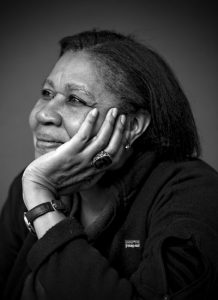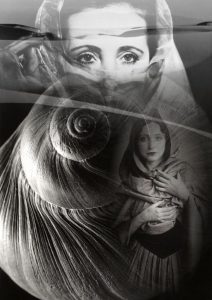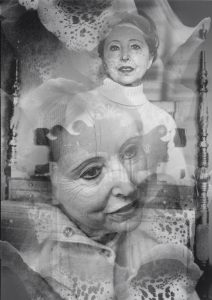July 5, 2017
“The heart can understand something deeper than the mind, but Zen is far deeper than the heart. The heart can be just an overnight stay. While you are going towards your being, your heart, your art, your music, your dance, your poetry, your painting, your sculpture, can be just one night’s halt. But you have to go deeper. You have to reach to the very roots of your life, from where you are getting nourishment every moment, to the point where you are joined with existence, you are no longer separate.”- Osho, Zen Stories
There are certain passages written by writers, whose hearts work synergistically with language. Not only is there melody, the lyricism captivates, prompts the reader to continue reading the lineup of words for the sheer joy of simply listening to their sound.
On my bookshelf, I discovered an old hardbound copy of A Woman Speaks, The Lectures, Seminars, and Interviews of Anais Nin. It’s a compilation of her speeches regarding woman as writer.
One lecture in particular caught my attention because Nin talks about writing from a place of authenticity. Very few writers understand the importance of writing from ones authenticity, that place of sincere receptivity, the place were consciousness flows through a creative act and opens to voice ones truth. You’ll find her speech ends this article.
So to begin, I’ve included the writing of some of my favorite writers. The list is extensive, but the ones that came to mind, always come to mind. As a source of inspiration, I’ve chosen passages from their stories that stir, stun, and strike the fire in my soul. Try to read the following fictional excerpts aloud and see what comes up for you.
Notice how from the start, from the first word, from the place where you begin, you’re swept away with the current of language: how deep the silence, the depth in which you’re immersed until the last word pronounces and announces the very end of the piece.
Listen with great intention and sensitivity to the sound of the words and what falls in between, as you read from Ernest Hemingway’s literary work, Islands in the Stream:

Ernest Hemingway, 1899-1961, Oak Park, Illinois, USA
“…He (Thomas Hudson) had a big pile of driftwood stacked against the south wall of the house. It was whitened by the sun and sand-scoured by the wind and he would become fond of different pieces so that he would hate to burn them. But there was always more driftwood along the beach after the storms and he found it was fun to burn even the pieces he was fond of. He knew the sea would sculpt more, and on a cold night he would sit in the big chair in front of the fire, reading by the lamp that stood on the heavy plank table and look up while he was reading to hear the northwestern blowing outside and the crashing of the surf, watch the great, bleached pieces of driftwood burning…”
Now at an easeful pace begin to read and listen to Jamaica Kincaid describe her scene from At the Bottom of The River:

Jamaica Kincaid, 1949-, St. John’s Antigua
“This, then, is the terrain. The steepest mountains, thickly covered, where huge, sharp rocks might pose the greatest danger and where only the bravest, surest, most deeply arched human feet will venture, where a large stream might flow, and, flowing perilously, having only a deep ambition to see itself mighty and powerful, bends and curves and dips in many directions, making a welcome and easy path for each idle rill and babbling brook, each trickle of rain fallen on land that lies sloping; and that stream at last swelled to a great, fast, flowing body of water, falls over a ledge with a roar, a loudness that is more than the opposite of complete silence, then rushes over dry, flat land in imperfect curves—curves as if made by a small boy playfully dragging a toy behind him—then hugs closely to the path made, ruthlessly conquering the flat plain, the steep ridge, the grassy bed; all day, all day, a stream might flow so, and then it winds its way to a gorge in the earth, a basin of measurable depth and breadth, and so collects itself in a pool: now comes the gloaming, for day will end, and the stream, its flow stilled and gathered up, so that trees growing firmly on its banks, their barks white, their trunks bent, their branches covered with leaves and reaching up, up, are reflected in the depths, awaits the eye, the hand, the foot that shall then give all this a meaning.”
Here’s an excerpt from D.H. Lawrence’s literary work, Women in Love:

D. H. Lawrence, 1885-1930, Eastwood, UK
“…She looked at him, as he leaned back against the faint crystal of the lantern light. She could see his face, although it was a pure shadow. But it was a piece of twilight. And her breast was keen with passion for him, he was so beautiful in his male stillness and mystery. It was a certain pure effluence of maleness, like an aroma from his firmly molded contours, a certain rich perfection of his presence that touched her with an ecstasy, a thrill of pure intoxication. She loved to look at him. For the present she did not want to touch him, to know the further, satisfying substance of his living body. He was purely intangible, yet so near. Her hands lay on the paddle like slumber, she only wanted to see him, like a crystal shadow, to feel his essential presence…”
Marguerite Yourcenar, an unforgettable excerpt from The Man Who Loved the Nereids:

Marguerite Yourcenar, 1903-1987, Brussels, Belgium
“…He stood on bare feet in the dust, heat, and stale smells of the post, beneath the narrow awning of a small café where several customers had left themselves fall on the chairs in the vain hope of protecting themselves from the sun. His old rust-colored trousers barely reached his ankles, and his pointed anklebones, the tips of his heels, his long, grazed, calloused soles, his supple toes, all belonged to that race of intelligent feet, accustomed to the constant embrace of the air and the earth, hardened by the roughness of the stones, which in Mediterranean countries still allow a clothed man a little of the freedom of a man who is naked. There were agile feet so different from the awkward, heavy ones trapped inside northern footwear… The faded blue of his shirt matched the tones of the sky bleached by the summer light; his shoulders and shoulder blades pierced through the tears in the cloth like lean rocks; his longish ears framed his head obliquely like the handles of a Greek vase; undoubtable traces of beauty could still be seen on his wan and vacant face, like the surfacing of an ancient broken statue in a wasteland. His eyes, like those of a sick animal, hid without distrust behind eyelashes as long as the eyelashes of mules; he held his right hand continuously stretched out, with the obstinate and insistent gesture of the archaic idols in the museums, who seem to demand from visitors the alms of their admiration, and an inarticulate braying issued from his wide-open mouth full of crooked teeth…”
Haruki Murakami, passage from After the Quake:

Haruki Murakami, 1949-, Kyoto, Japan
“That night, lying in her broad, pristine bed, Satsuki wept. She recognized that she was heading towards death. She recognized that she had a hard, white stone inside herself. She recognized that a scaly, green snake was lurking somewhere in the dark. She thought about the child to which she never gave birth. She had destroyed that child, flung it down a bottomless well. And then she had spent 30 years hating one man. She had hoped that he would die in agony. In order to bring that about, she had gone so far as to wish in the depths of her heart for an earthquake. In a sense, she told herself, I am the one who caused that earthquake. He turned my heart into a stone; he turned my body to stone. In the distant mountains, the grey monkeys were silently staring at her. Living and dying are, in a sense, of equal value.”
A memorable passage from The Accidental, a novel by Ali Smith:

Ali Smith, 1962-, Inverness, UK
“Disdainful as a cat etc. not adequate to describe what was happening, really. KO’d by a heavyweight. Shot through the chest. Earnest surgeons opening his unconscious like a splayed ribcage. Heart an open flower, beautifully petalled, beating, symmetry. Shock and heat and art had seared off all his skin, then he’d been metalled over with a new self and six new senses, a new tongue that could speak only in lines that were pentameter, intelligences that swore it was all poetry and signs:
a girl called Amber walked across a room
and everything became a new-made poem.”
So how do I get here from there? How do I write from the heart so that the reader feels my sincerity, my authenticity?
Anais Nin, in the lecture from her book, A Woman Speaks, addresses the topic of writing authentically, and this is what she advises:

Anais Nin, Photo-montage, I. Ebaen, 2017
“…As a writer I wanted simply to take all the various expressions of art into writing, for I believed that each art must nourish the other, each one can add to the other. And I would take into writing what I learned from dancing, what I learned from music, what I learned from design, what I learned from architecture. In ever form of art there is something that I wanted to include, and I wanted writing, poetic writing, to include them all. Because I thought always of art as a supreme magic…
On writing so succinctly; I think it’s really the fact that I began so soon to tie words to experience and think in terms of words or in terms of images. I think that spontaneity has entirely to do with the fact that writing became a habit – a stubborn pursuit. It was the persistence and the great love of my craft that finally became a discipline, which made me a crafts-woman and a writer. I wrote every day. There was no more than that. There was no studying of writing: there was literary discipline, there was only the reading and receiving of experience. And I had to be open because I had to write it in the diary…
The diary became the diary of an adventurer. It made me look at my life, at the sorrowful moments, at moments of great disintegrating experiences, and constantly reminded me that it was an adventure, that it was a tale. Somehow the transference into writing gave it just that little bit of space, which I needed to sustain the painful part of the experience.

Anais Nin, Photo-montage, I. Ebaen, 2017
So there were always those two guiding objectives. One was growth, watching my own growth; then, in watching my own growth it naturally follows that I watched and observed the growth of others around me.
So your attentiveness, your care for what is happening, your watchfulness, your meditation on what happens, your examination of what happens, the fact that you are observing others that you are not only writing down your life but that you are also naturally concerned with the growth of people around you, make that a necessary part of our existence.
Because what we don’t write down often remains nebulous in our feelings. And at this moment when women are trying to find their identity, I found that the thing most lacking was this power of expression, of what you feel in a certain situation, what you think, what you believe, which you want to impart to others…
I do want you to become very aware of your orientation; of how much contact you have with yourself. In the early diaries I spoke of my feeling that I was playing all the roles demanded of woman, which I had been programmed to play.
But I know also that there was a part of myself that stood apart from that and wanted some other kind of life, some other kind of authenticity.
As a woman I felt I wanted to keep authenticity of awareness for others; I wanted insight rather than the imagination. I saw a lot of imagination in the artists around me and I wanted to have basic truths recorded.

Ronnie D. Laing, Scottish, Psychologist, 1927-1989

Gaston Bachelard, French Philosopher, 1884-1962
R.D. Laing describes this authenticity as a process of constant peeling off the false selves.
Gaston Bachelard, the French philosopher, said sometimes he thinks that what we have suffered from is silence. The silence which surrounds our acts; the silence which surrounds our relationships; the things we cannot say, that we cannot tell others.
There was a moment in America when I was afraid that people had decided never to read again, never to depend on literature, and never even to talk again. I was very troubled until I realized that what they objected to was babble and not talking together; what they objected to was a literature that didn’t bring them life but abstractions.
And therefore, for the novel not to die- we had to return to the sources of life, which meant biography, which meant basing all happenings on truth, but not forgetting that art would then transform this truth into poetry…
You can begin by looking at it, for there is so much that we don’t want to look at. This wanting to see is terribly important to our direction. And to find this direction I used every possible means. Not only friendship and psychology and therapy, but also a tremendous amount of reading, exploration, listening to others- all these things contributed to my discovering who I really was. It wasn’t as final or definite as it might sound now, because it doesn’t happen finally.
It is a continuum; it’s something that goes on all of your life. But once I was at least on the track of what I could do, then the obstacles began to move away. It was not something that anybody could give me, it was something that I had to find inside myself.”

Anais Nin, Photo.montage, I. Ebaen, 2017
Each one of these writers writes from his or her authenticity, has gone deeper to consider, to recognize and utilize their authentic voice. Each piece of writing both unique and sincere; each in its own way expressing the voice of experience.
Life, and the lessons learned from my life, cannot be relived, imitated, or duplicated. I can never call your experience mine unless it happens to me; and then what you or I experience never happens the same way twice—existence is that creative!
Writers photographs from Google Search.
